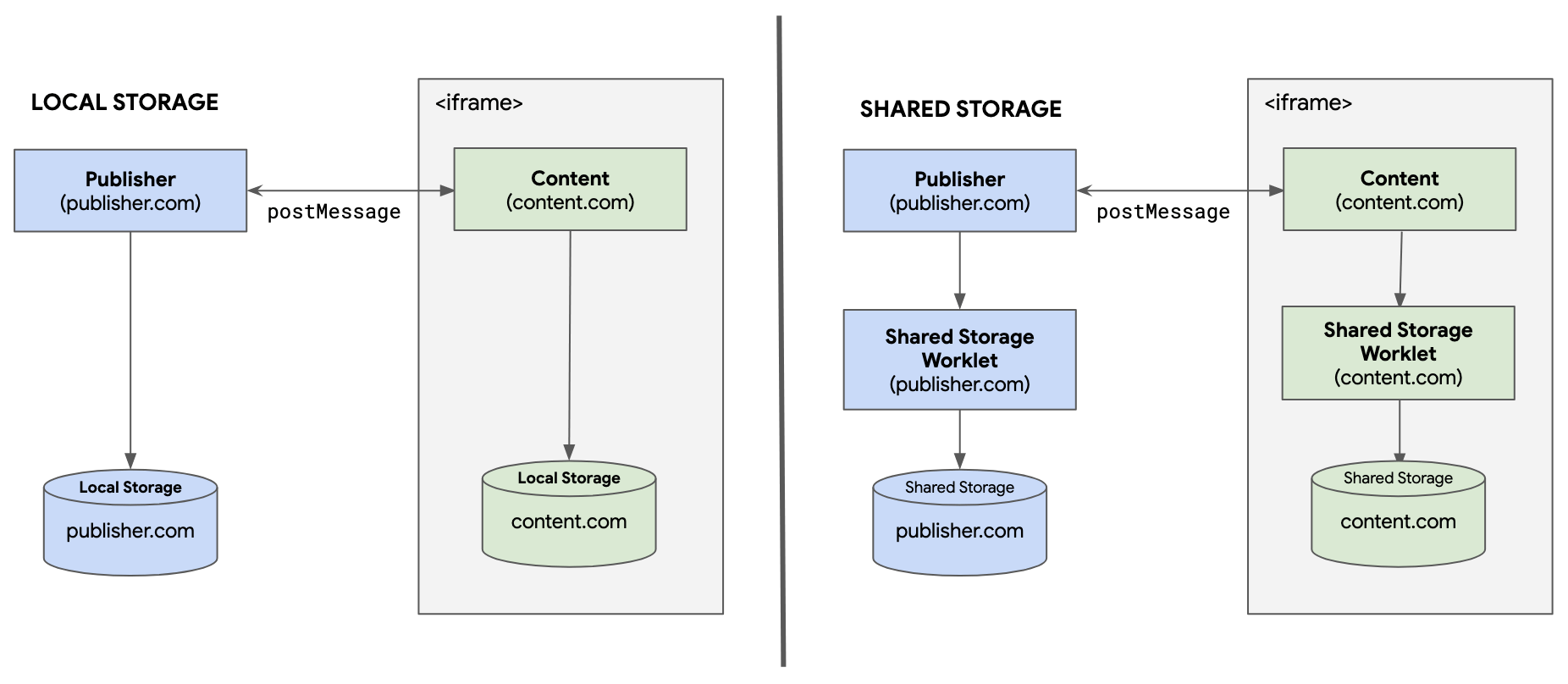Communication with embedded frames
This article provides information on how communication differs between an embedder and content embedded inside different types of frame (i.e., an <iframe> and a <fencedframe>), and how passed data can be stored.
How to communicate between the embedder and an <iframe>

When the third-party code is embedded in an <iframe>, the <iframe> and the embedder can send messages freely to each other to request data to be written into their client-side shared storage. The embedder can send a request to that <iframe> to write data into its own third-party storage with a cross-document communication channel using Window.postMessage(). The third party can also send postMessage() requests to the embedder.
From the <iframe>, you can listen to a message event that comes from the embedder. When the embedder dispatches a message to the <iframe> using postMessage(), the <iframe> can take that data and store it in its own client-side shared storage. Conversely, the <iframe> can dispatch a message that the embedder can listen to, and respond by writing data into its shared storage.
How to communicate between the embedder and a <fencedframe>
Fenced frames are intended to be used for cases such as displaying targeted ads selected via the Protected Audience API and WindowSharedStorage.selectURL(). Communicating between <fencedframe>s and other pages outside the <fencedframe> on the page is intentionally limited, but one method of communication between the embedder and shared storage worklets does exist — FencedFrameConfig.setSharedStorageContext().
Note:
Within the same <fencedframe> tree, communication between frames is allowed. For example, a root <fencedframe> can send a message to a child <iframe> in its own tree, and a child <iframe> can send a message to the parent <fencedframe>.
Let's look at a more complex example that uses a Select URL output gate operation to render an ad in a <fencedframe>.

In this example, a publisher asks a third-party content provider to render some content on the page. The content chosen with WindowSharedStorage.selectURL() is rendered in a <fencedframe>, and the content contains an <iframe> from a measurement provider. Note that a publisher can represent any entity that is embedding a third-party <fencedframe>. Also, a measurement provider represents any nested third-party code running in a <fencedframe> of a different third party.
To pass data into a <fencedframe> to be used in a shared storage worklet, the embedder can set the data in a FencedFrameConfig. That value will be available as WorkletSharedStorage.context inside the shared storage worklet. This data is not available outside a worklet, and can only be accessed inside a secure and private environment that a shared storage worklet provides.

When a selectURL() call returns a FencedFrameConfig, the frame embedder can pass in data by calling setSharedStorageContext(data):
const fencedFrameConfig = await window.sharedStorage.selectURL(
"creative-rotation",
urls,
{
// …
resolveToConfig: true,
},
);
fencedFrameConfig.setSharedStorageContext("some-data");
// Navigate the fenced frame to the config.
document.getElementById("my-fenced-frame").config = fencedFrameConfig;
setSharedStorageContext(data) must be called on the fencedFrameConfig before the intended <fencedframe> element recipient has its config attribute set to fencedFrameConfig, as this triggers the frame to navigate.
Inside a shared storage worklet, WorkletSharedStorage.context can then be accessed to retrieve the data:
class ReportingOperation {
async run() {
sharedStorage.set("some-data-from-embedder", sharedStorage.context);
}
}
register("send-report", ReportingOperation);